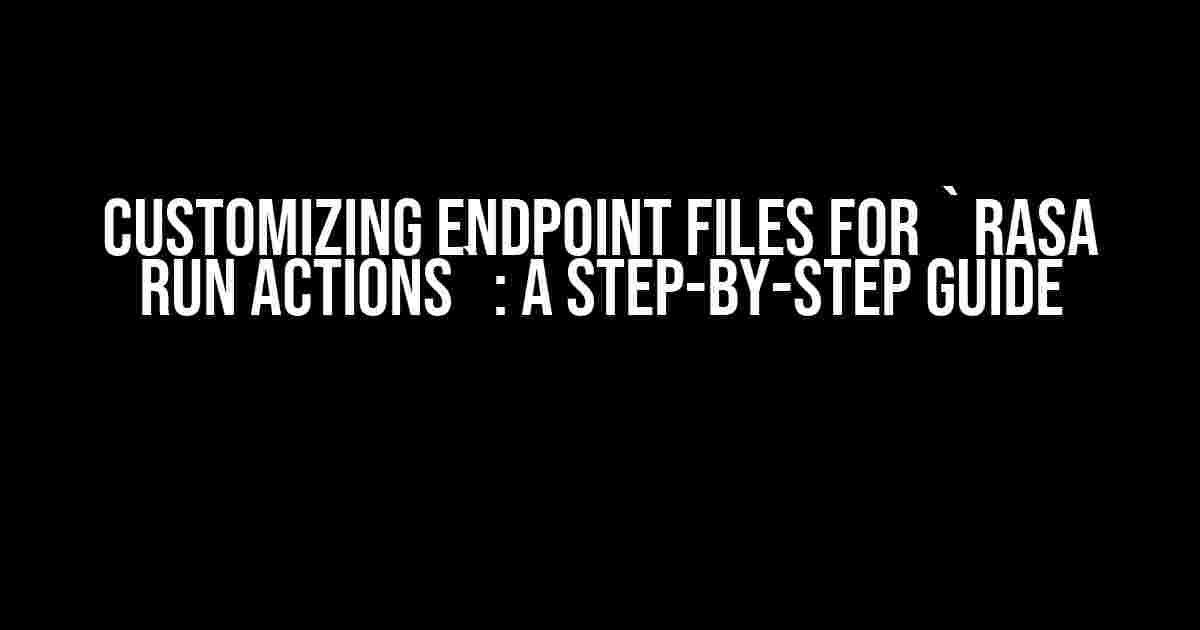Are you tired of being limited by the default endpoint file for `rasa run actions`? Do you want to take your Rasa development to the next level by specifying a custom endpoint file? Look no further! In this comprehensive guide, we’ll dive into the world of custom endpoint files and show you exactly how to make the most of this powerful feature.
What is an Endpoint File?
Before we dive into the nitty-gritty of custom endpoint files, let’s take a step back and understand what an endpoint file is. In Rasa, an endpoint file is a configuration file that defines the URL and authentication details for the action server. This file is used by `rasa run actions` to connect to the action server and execute custom actions.
The Default Endpoint File
By default, Rasa uses a predefined endpoint file located at `endpoints.yml`. This file contains the basic configuration for the action server, including the URL, username, and password. While this default file is sufficient for most use cases, it can be limiting for more complex or customized setups.
Why Do I Need a Custom Endpoint File?
There are several scenarios where a custom endpoint file becomes necessary:
-
You want to use a custom action server URL or port.
-
You need to authenticate with the action server using a custom username and password.
-
You want to specify additional configuration options not available in the default file.
-
You’re using a load balancer or proxy server that requires custom configuration.
Specifying a Custom Endpoint File
Now that we’ve established the importance of custom endpoint files, let’s dive into the step-by-step process of specifying one:
Step 1: Create a New Endpoint File
Create a new file with a `.yml` extension (e.g., `custom_endpoints.yml`) in the same directory as your Rasa project. This file will contain the custom configuration for your action server.
# custom_endpoints.yml action_endpoint: url: "http://my-custom-action-server.com" username: "my_username" password: "my_password"
In this example, we’ve specified a custom URL, username, and password for the action server.
Step 2: Specify the Custom Endpoint File
To use the custom endpoint file, you need to specify it when running `rasa run actions` using the `–endpoints` flag:
rasa run actions --endpoints custom_endpoints.yml
This tells Rasa to use the `custom_endpoints.yml` file instead of the default `endpoints.yml` file.
Advanced Configuration Options
In addition to the basic configuration options, you can specify additional settings in your custom endpoint file:
| Option | Description |
|---|---|
| ssl_certificate | Path to the SSL certificate file |
| ssl_key | Path to the SSL key file |
| headers | Custom headers to include in the request |
| timeout | Timeout in seconds for the action server connection |
Here’s an updated example that includes some of these advanced options:
# custom_endpoints.yml
action_endpoint:
url: "http://my-custom-action-server.com"
username: "my_username"
password: "my_password"
ssl_certificate: "path/to/ssl_certificate.pem"
ssl_key: "path/to/ssl_key.pem"
headers:
Content-Type: "application/json"
timeout: 30
Common Pitfalls and Troubleshooting
While specifying a custom endpoint file is relatively straightforward, there are some common pitfalls to watch out for:
-
Incorrect YAML formatting: Double-check that your custom endpoint file is formatted correctly, with proper indentation and syntax.
-
File path issues: Ensure that the path to your custom endpoint file is correct and accessible by Rasa.
-
Authentication errors: Verify that your custom endpoint file contains the correct username and password for the action server.
Conclusion
In this comprehensive guide, we’ve covered the ins and outs of specifying a custom endpoint file for `rasa run actions`. By following these step-by-step instructions, you’ll be able to take full advantage of Rasa’s customization options and ensure seamless communication with your action server.
Remember to experiment with different configuration options and troubleshoot common pitfalls to get the most out of your custom endpoint file. Happy coding!
Keywords:
- rasa run actions
- custom endpoint file
- action server
- endpoints.yml
- yaml configuration
With this guide, you should be well on your way to mastering custom endpoint files for `rasa run actions`. If you have any further questions or need additional guidance, feel free to ask in the comments below!
Frequently Asked Question
If you’re wondering about customizing your Rasa actions, you’re in the right place! Below, we’ve got the scoop on specifying custom endpoint files for `rasa run actions`.
Can I specify a custom endpoint file for `rasa run actions`?
Yes, you can specify a custom endpoint file for `rasa run actions`. You can do this by using the `–endpoints` flag followed by the path to your custom endpoint file. For example: `rasa run actions –endpoints my_custom_endpoints.yml`.
What format should my custom endpoint file be in?
Your custom endpoint file should be in YAML format. This file should contain the definitions for your custom actions, including the endpoint URL, method, and any required authentication details.
Can I use a JSON file instead of YAML for my custom endpoint file?
No, Rasa only supports YAML files for custom endpoint files. If you try to use a JSON file, you’ll get an error. So, make sure to stick with YAML!
What if I want to specify multiple custom endpoint files?
You can specify multiple custom endpoint files by separating them with commas. For example: `rasa run actions –endpoints my_custom_endpoints1.yml,my_custom_endpoints2.yml`. This way, you can define different endpoints for different actions or environments.
Will my custom endpoint file override the default Rasa endpoints?
Yes, your custom endpoint file will override the default Rasa endpoints. So, make sure to include all the necessary endpoints in your custom file, or you might end up missing some crucial functionality.
